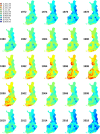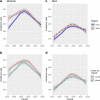Regional and gender-specific analyses give new perspectives for secular trend in hip fracture incidence
- PMID: 33712877
- PMCID: PMC8387269
- DOI: 10.1007/s00198-021-05906-6
Regional and gender-specific analyses give new perspectives for secular trend in hip fracture incidence
Abstract
In this study, we found that regional disparity in incidence of hip fractures has converged. Also, annual hip fracture risk ratios between genders have systematically diminished over time.
Introduction: Several studies have reported secular trends in hip fracture incidence, but knowledge about the possible causes is limited. We studied potential explanations by examining spatio-temporal epidemiology of the fractures and estimating relative risks between genders.
Methods: This observational study was based on all inpatient hospital discharges in 1972-2018 in Finland. We divided the data by gender, 5-year age groups and Finnish sub-regions and estimated gender and age standardized spatio-temporal rates of hip fractures by using a Bayesian age-period-cohort model.
Results: In 1972, women's hip fracture incidence was 1.2-1.3 times higher in western and coastal Finland compared to eastern and inland areas. Also, women had approximately 1.7 times higher average risk to get a hip fracture compared to men. Today, the hip fracture differences between the areas have converged to insignificant and the relative risk between genders has diminished to 1.2. Age-specific relative risks indicate greater hip fracture risk for younger men and older women, and the women's risk increases beyond the risk of men at age 65 which is ten years later than in the beginning of the study period.
Conclusion: Incidence of hip fracture has converged significantly between regions and genders. Especially factors related with socioeconomic development and increased frailty and longevity seem to be important. The hip fracture incidence rate ratio between women and men has systematically decreased in time, and more attention should be paid to hip fracture risk in men in the future.
Keywords: Epidemiology; Fracture prevention; Fracture risk assessment; General population studies; Orthopaedics.
© 2021. The Author(s).
Conflict of interest statement
Salla-Riikka Pekonen, Juho Kopra, Heikki Kröger, Toni Rikkonen and Reijo Sund declare that they have no conflict of interest. There has been no significant financial support for this work that could have influenced this outcome.
Figures



Similar articles
-
Changes in hip fracture epidemiology: redistribution between ages, genders and fracture types.Osteoporos Int. 2002 Jan;13(1):18-25. doi: 10.1007/s198-002-8333-x. Osteoporos Int. 2002. PMID: 11878451
-
Epidemiology of hip fractures.Bone. 1996 Jan;18(1 Suppl):57S-63S. doi: 10.1016/8756-3282(95)00381-9. Bone. 1996. PMID: 8717549 Review.
-
Evidence from data searches and life-table analyses for gender-related differences in absolute risk of hip fracture after Colles' or spine fracture: Colles' fracture as an early and sensitive marker of skeletal fragility in white men.J Bone Miner Res. 2004 Dec;19(12):1933-44. doi: 10.1359/JBMR.040917. Epub 2004 Sep 20. J Bone Miner Res. 2004. PMID: 15537435
-
Continued decline in hip fracture incidence in Norway: a NOREPOS study.Osteoporos Int. 2016 Jul;27(7):2217-2222. doi: 10.1007/s00198-016-3516-8. Epub 2016 Feb 22. Osteoporos Int. 2016. PMID: 26902091
-
Mortality following hip fracture: Trends and geographical variations over the last SIXTY years.Injury. 2023 Feb;54(2):620-629. doi: 10.1016/j.injury.2022.12.008. Epub 2022 Dec 9. Injury. 2023. PMID: 36549980 Review.
Cited by
-
Where's the break? Critique of radiographic vertebral fracture diagnostic methods.Osteoporos Int. 2021 Dec;32(12):2391-2395. doi: 10.1007/s00198-021-06207-8. Epub 2021 Oct 21. Osteoporos Int. 2021. PMID: 34674023 Free PMC article. No abstract available.
-
Combining Register and Radiological Visits Data Allows to Reliably Identify Incident Wrist Fractures.Clin Epidemiol. 2023 Sep 20;15:1001-1008. doi: 10.2147/CLEP.S421013. eCollection 2023. Clin Epidemiol. 2023. PMID: 37750092 Free PMC article.
-
Cost-effectiveness analysis of proximal femoral nail versus bipolar hemiarthroplasty for femoral neck fracture.J Orthop Surg Res. 2024 Aug 27;19(1):507. doi: 10.1186/s13018-024-04941-3. J Orthop Surg Res. 2024. PMID: 39192359 Free PMC article.
-
Predictors of and predictive nomogram for cut-out of proximal femur nail anti-rotation device in intertrochanteric fractures.Arch Orthop Trauma Surg. 2023 Jul;143(7):3985-3995. doi: 10.1007/s00402-022-04676-y. Epub 2022 Nov 8. Arch Orthop Trauma Surg. 2023. PMID: 36348087
-
Relatively low and moderate pre-fracture serum 25-hydroxyvitamin D levels associated with the highest survival in elderly hip fracture patients in Finland: a minimum 3-year follow-up.Osteoporos Int. 2022 Mar;33(3):611-621. doi: 10.1007/s00198-021-06094-z. Epub 2021 Sep 30. Osteoporos Int. 2022. PMID: 34591132 Free PMC article.
References
Publication types
MeSH terms
LinkOut - more resources
Full Text Sources
Other Literature Sources
Medical

